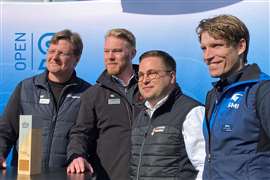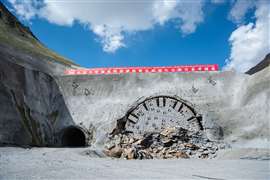Foundations: Digging deep
14 October 2011

The quality of the foundations of any building project is key to its success, but there are many different ways to achieve the stability necessary for a safe and lasting structure.
Efficiency and operator safety are, of course, important and there have been a number of new launches this year in all sectors of the foundations world.
As a part of Junttan’s 35th anniversary, the new Junttan X-series piling rigs plus the SHK hammer series were launched in May. Meanwhile, Soilmec’s new SR-80 LHR is a rotary rig specifically designed to work in low headroom space. Also, a new method of evaluating the integrity of concrete foundations has been developed through a partnership between Pile Dynamics and Foundation & Geotechnical Engineering – the Thermal Integrity Profiler (TIP).
Soilmec is owned by Trevi, one of the leading foundations companies in the world. Trevi’s managing director Stefano Trevisani was relatively upbeat about the foundations market worldwide, following on from the global economic problems of the past few years.
He reported that South America was looking good, adding that Far East business was better than Europe at the moment. Trevi tried operating in China some 15 years ago, with limited success.
“China is now doing well,” said Mr Trevisani, “and in India we have a small factory to support sales in that country.”
In Europe, he acknowledged that Trevi’s home country of Italy had faced problems, but said, “Italy didn’t have to fall too far, compared with Spain and Greece.”
He added that Italy was more or less stable, but that it was responsible for only 10% of total group revenue.
“In Eastern Europe, we are selling equipment but there is not much contracting business,” he said.
There were distinct advantages of Soilmec being owned by Trevi, he said, in that the machinery is created and used within the group. “We can control innovation. We design and manufacture for a purpose, and we move forward. That is an important part of the process.”
Promising feedback
Junttan said that the feedback from the field on its new X-series piling rigs had been “more than promising”. It claimed the X-series had added plenty of value to rig ownership through its smooth and economical operation, together with easy and proactive maintenance.
It said reports of increases in productivity and a decrease of noise emissions had been significant, and had raised interest among the whole pile driving society.
The X-series represents the latest technology in the field of pile driving, according to Junttan. It comprises the PMx20, PMx22, PMx24 and PMx25 pile driving rigs. They incorporate new sophisticated hydraulic system, controlled by the new Junttan X control system, which aims to ensure economical and environmentally-friendly operation while remaining efficient.
The new X control system is also said to be essential to get the most out of the new SHK hydraulic hammer series developed by Junttan.
This completely new hydraulic hammer is nicknamed “Shark”. Junttan is undertaking a demonstration tour to show the benefits of this new hammer series, which covers the energy scale from 36 to 129kNm at maximum drop height. Upgrading current rigs with the new X hammer control system and SHK hammer is also being introduced during the tour.
The manufacturer recently marked its 35th anniversary with a new look, including an updated logo and a revamped website. It said the information on the website had been substantially increased and made easier to use.
It celebrated the anniversary with its staff and a number of key customers at its factory in Kuopio, Finland, hosted by the company’s major shareholder, Ilkka Brotherus.
The company was founded in 1976 by Pentti Heinonen, who attended the celebration. His son Juha is still a shareholder and on the company’s board, although Mr Brotherus’ company Sinituote – a manufacturer of household products in the Baltic region – became the major shareholder in 2010.
Mr Brotherus said that he bought the company “because it has the leading technology, is a growing business and is a leading global actor with long-lasting relationships with its dealers and customers”.
He described the company as still being a family business. “The point is that the values on which the products are based are long term, not months or single years. For family companies, a quarter of a century is an important time.”
He told the gathering of dealers and customers, “You professionals must have state-of-the-art equipment to support your businesses.”
Reduced noise
The Shark hammers are said to reduce noise by 10dB, while Junttan claims 9 to 18% higher productivity along with better adaptability, as the same hammer can be used on several sites.
Junttan hammers are said to be suitable for driving steel tube pipes, sheet piles, pre-cast concrete and timber piles. The stroke and blow rates are adjustable to optimise the pile driving performance in all conditions.
he ram weight can also be changed depending on pile type requirements. The hammers can be mounted on all kinds of leaders, or can be suspended freely, the company said.
Junttan hydraulic impact hammers are said to have low environmental impact. The company claims that 95% of the hammer’s energy is transferred to the pile. Also, it said that a smooth installation process helped ensure that there was as little impact on the environment as possible.
The Shark hammers have a maximum drop height of 1.2m and run at either 50 to 120-plus blows per minute or 60 to 100-plus blows per minute.
Junttan hammers are also used without Junttan rigs. For this, the company manufactures hydraulic power units, and it has just launched the 10XCU.
The smallest of its powerpacks, the 10XCU claims easy handling, durability and good fuel economy, as well as low noise. It uses Junttan’s latest control technology to manage the piling process, and it replaces the 10CCU model.
The redesigned company logo is accompanied by a new slogan – “respecting ground”. Managing director Tommi Lindbom said this had been chosen because “the ground is the foundation”.
He added that the company believed that environmental issues were increasing, and that service and project planning was becoming more and more important.
All its machines are made to order and the average time for completion is 16 weeks, although some more complicated machines can take six to eight months.
Juha Heinonen said, “There is no single solution. It is important that our customers are satisfied, and we have very few customers who are ex-customers.”
Mr Lindbom added that the Kuopio site was the most modern factory for piling in the world.
Expanded capacity
At Soilmec, it was felt that the growth of urban areas meant it had to expand the capacity of its rigs to work in low space conditions – under power or telephone lines, inside pre-existing structures, under bridges, etc.
To meet growing market demand, Soilmec has developed a conversion low-headroom kit to be mounted on its SR-65, SR-70 and SR-80 for large diameters and deep piles.
The new Soilmec SR-80 LHR rig is designed to be mounted on the SR-80 base carrier. It can be also be purchased as a kit, including a special mast, a modified boom articulation and a new rotary group.
As with other Soilmec rigs, the SR-80 LHR is fitted with the Drilling Mate System (DMS), developed by the company for monitoring and control of working functions. The important operating parameters and drilling data are displayed on a 300mm touch screen.
As with other Soilmec models, the DMS system offers an option of being connected directly with the Soilmec customer care server for live trouble shooting. Wherever in the world the equipment is being used, the data can be viewed and analysed at the Soilmec headquarters in Italy so that advice can be given. Even diesel consumption can be monitored.
Soilmec said, however, that the particularly innovative and specific solutions developed for the SR-80 LHR were the special rig drilling group, the new mast, the new crowd system, the modified boom articulation and the rotary.
The modular mast ranges from 5.8 to 9.8m. The company said it allowed the rig clearance to be adapted for working safely even in difficult and risky situations – under power lines for example. The rotary group is designed for the dedicated ten section Soilmec Kelly bar passage and drive, while the rotary reaches 250kNm maximum torque and a maximum speed of 100rpm. The crowd system includes a strong chain that can transmit 230kN pull-up and pull-down force.
Training project
Trevi, meanwhile, runs the FTA (Foundations Technology Academy) an international training project aimed at people willing to be introduced into the foundation sector for civil engineering, those who are already working within the sector, but also those who are willing to increase their own knowledge with regard to foundation technologies and relevant equipment.
It is a permanent school which focuses on the individual's safety in the work place. Trevi said this was the starting point from which it would be then possible to develop the theoretical and practical knowledge which can add to professional growth.
The FTA carries out the training programme at the Trevi Group headquarters in Cesena, in the Romagna region of Italy. The Academy organises and runs training and advanced training courses both in Italian and in English.
New quality control devices have also been launched this year. The Thermal Integrity Profiler (TIP) from Pile Dynamics (PDI) and Foundation & Geotechnical Engineering (FGE), for example, uses the heat generated by curing cement – hydration energy – to assess the quality of cast in place in concrete foundations such as drilled shafts, bored piles, augered cast-in-place, continuous flight auger piles and drilled displacement piles.
PDI said that because temperatures within the concrete foundation were dependent on its diameter and distance to the centre of the shaft, TIP measurements can be used to estimate the actual shape of the shaft, including the previously difficult to determine thickness of concrete cover.
The TIP assesses the concrete quality of the entire cross-section and along the entire length of the foundation. PDI added that test results were available as early as 12 hours after concrete is poured, allowing construction to continue.
Benoto method
Buma CE, a Korean manufacturer of foundation equipment, said the most important equipment for the Benoto (all casing) method was the casing oscillator.
This machine holds and drives casing tube into the earth. And while it is driving, inside soil or gravel can be excavated with a hammer grab. After concreting, the casing tube can be extracted the same way.
Sales manager Jack Lim said that the Buma machine could drive and extract casing tube up to a maximum of 80m vertically with a maximum diameter of 3.3m.
With Buma’s reverse circulation drilling system (RCD), also known as the air-lift system, compressed air is injected into the drill pipe below the water level, just above the drill bit. This reduces the density of the internal water column and starts the circulation. The mixture of water, air, and cuttings is then flushed out through the drill pipe into settling tanks or outside.
Mr Lim said working with RCD rigs was a highly-efficient, safe and environmentally friendly solution for drilling large diameters – up to 3.3m – and depths of more than 100m.
The RCD Drill Bit was designed to be suitable to drill hard rock layers with the RCD system. With special cutters mounted on the drill bit, it can drill rock with a strength of up to 250MPa.
Extra performance
Italian firm Casagrande claims to have sold 2,600 C6 crawler drilling rigs since it was introduced, and it has now launched the C6 XP, which stands for extra performance.
Described as compact, sturdy and versatile, the C6 XP can be used for micro-piles, anchorages and jet grouting.
Available in both manual hydraulic and radio-controlled version, the new C6 XP is equipped with a full load sensing hydraulic system which Casagrande said allowed a reduction in fuel consumption of up to 25%.
The mast is now fitted with improved jointing that allows work to be done at zero distance from a perpendicular wall. Furthermore, the machine has been equipped with new sliding lattice extensions that can reach a depth of 18m in jet grouting mode. A Double Rotary head can be fitted, as can the HB 50A rotopercussion Drifter.
Meanwhile, Marti Gründungstechnik, one of the leading foundation and tunneling contractors in Switzerland, recently obtained a new IHC Fundex F2800 machine.
IHC Fundex said that with its new model HS rotary head, Marti optimised its efficiency and increased its daily production compared to other machines.
The new F2800 machine was supplied with a 440kW, V8 diesel engine from Deutz, and hydraulics from Rexroth. IHC Fundex said Marti was able to install piles of 26m in the standard configuration of the machine, and if it installed the optional clamping system, it would be able to install displacement piles up to a depth of about 31m.
The trackplates have a width of 900mm and the total width of the undercarriage is nearly 5m, which is said to ensure high stability. With some minor adjustments, the F2800 can be used for the installation of driven piles as well.






